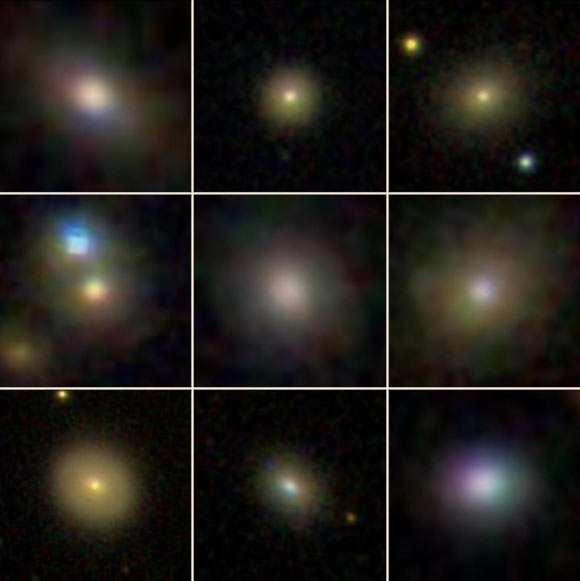Black Hole-Driven Winds Suppress Star Formation in Dwarf Galaxies | Astronomy – Sci-News.com
Supermassive black hole-driven outflows in dwarf galaxies have a significant impact on the evolution of these galaxies by suppressing star formation, according to new research from the University of California Riverside.

Dwarf galaxies hosting active galactic nuclei that have spatially extended outflows. Image credit: Sloan Digital Sky Survey.
“Astronomers have suspected for the past couple of decades that supermassive black holes at the centers of large galaxies can have a profound influence on the way large galaxies grow and age,” said Professor Gabriela Canalizo, co-author of the study.
“Our findings now indicate that their effect can be just as dramatic, if not more dramatic, in dwarf galaxies in the Universe.”
The researchers used data from the Sloan Digital Sky Survey (SDSS) to identify 50 dwarf galaxies, 29 of which showed signs of being associated with black holes in their centers.
Six of these 29 galaxies showed evidence of high-velocity ionized gas outflows emanating from their active black holes.
“Larger galaxies often form when dwarf galaxies merge together. Dwarf galaxies are, therefore, useful in understanding how galaxies evolve,” said doctoral student Christina Manzano-King, first author of the study.
“Dwarf galaxies are small because after they formed, they somehow avoided merging with other galaxies. Thus, they serve as fossils by revealing what the environment of the early Universe was like.”
“Dwarf galaxies are the smallest galaxies in which we are directly seeing winds — gas flows up to 1,000 km/s (2.2 million mph) — for the first time.”
As material falls into a black hole, it heats up due to friction and strong gravitational fields and releases radiative energy. This energy pushes ambient gas outward from the center of the galaxy into intergalactic space.
“What’s interesting is that these winds are being pushed out by active black holes in the six dwarf galaxies rather than by stellar processes such as supernovae,” Manzano-King said.
“Typically, winds driven by stellar processes are common in dwarf galaxies and constitute the dominant process for regulating the amount of gas available in dwarf galaxies for forming stars.”
Astronomers suspect that when wind emanating from a black hole is pushed out, it compresses the gas ahead of the wind, which can increase star formation.
But if all the wind gets expelled from the galaxy’s center, gas becomes unavailable and star formation could decrease.
The latter appears to be what is occurring in the six dwarf galaxies the team identified.
“In these six cases, the wind has a negative impact on star formation,” said Dr. Laura Sales, co-author on the study.
“Theoretical models for the formation and evolution of galaxies have not included the impact of black holes in dwarf galaxies. We are seeing evidence, however, of a suppression of star formation in these galaxies.”
“Our findings show that galaxy formation models must include black holes as important, if not dominant, regulators of star formation in dwarf galaxies.”
The results were published in the Astrophysical Journal.
_____
Christina M. Manzano-King et al. 2019. AGN-Driven Outflows in Dwarf Galaxies. ApJ 884, 54; doi: 10.3847/1538-4357/ab4197





